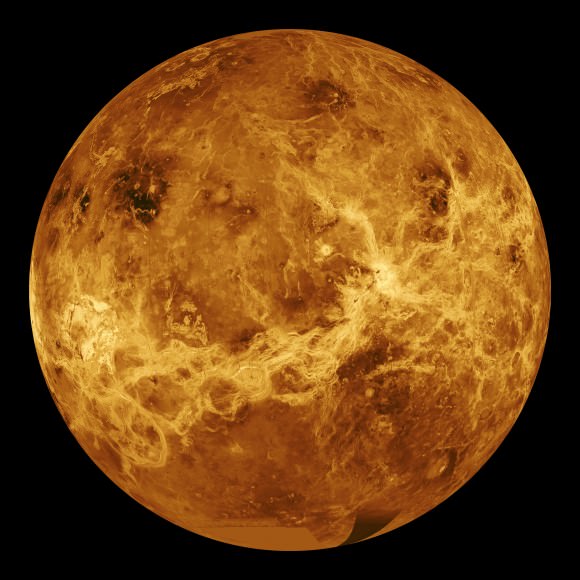Earth is the third planet from the Sun, and the climate here is just right for life. Here in our Solar System, there are planets both hotter and colder than Earth.
So… which one is the hottest?
You might think it’s Mercury, the planet closest to the Sun. Mercury orbits at a distance of only 58 million kilometers, travelling in a blast-furnace of scorching radiation. Its temperature can skyrocket to 700 Kelvin, or 426 degrees Celsius on the sunward side. In the shadows, temperatures plunge down to 80 Kelvin, which is -173 degrees Celsius
Mercury sure is hot, but Venus is hotter.

Venus remains that same temperature no matter where you go on the planet. At the North Pole? 735 Kelvin. At night? 735 Kelvin. Daytime at the equator? You get the point.
So, why is Venus so much hotter than Mercury, even though it’s further away from the Sun? It’s all about the atmosphere.
Mercury is an airless world, not unlike the Moon. Venus, has a very thick atmosphere of CO2, which adds incredible pressure, and traps in the heat.

Venus also shows us what happens when carbon dioxide levels just keep on rising. Radiation from the Sun is absorbed by the planet, and the infrared heat emitted is trapped by the carbon dioxide, which creates a runaway greenhouse effect.
You might think a planet this hot with such extreme temperature and pressure, would be impossible to explore.
And if you did, you’d be wrong.
The Soviets sent a series of spacecraft called Venera, which parachuted down through the thick atmosphere and returned images from the surface of Venus. Although the first few missions were failures, this taught the Soviets just how hellish the Venusian environment really is.

Venera 13 made it down to the surface in nineteen-eighty-one and survived for one-hundred-and-twenty-seven minutes, sending back the first color pictures of Venus’ surface.
The hottest planet in our solar system is Venus,
When it comes to temperature, distance from the Sun matters, but it takes a backseat to wrapping a planet in a atmospheric blanket of carbon dioxide.
We release this explainer videos every Monday and Thursday from the Universe Today YouTube Channel. Click here to Subscribe to the channel.


I wonder why folks insist on blaming the temperature of the Venusian atmosphere on its CO2 content, rather than on the fact that the pressure at the surface is so intense. The atmosphere on Venus isn’t so different in composition at the 1-bar level (as opposed to its surface), and the temperature there is much closer to Earth surface normal, with a temperature easily correlated with the planet’s smaller orbit.
Am I the only one that’s considered the application of both “ideal” and “real” gas laws on the atmosphere of Venus? You know, the ones where an increase in pressure equals an increase in temperature? Is there a good reason (or reasons) why I should NOT have? Or is this all just because “Carl Sagan said so,” therefore CO2 = Venusian warming?
Sure didn’t seem to do much for Mars. Or does atmospheric pressure work differently at different orbits?
Isn’t there a CO2 greenhouse effect? What if the atmosphere was as dense but 100% nitrogen?
That’s my whole point, Steve: according to the laws I mentioned, ANY atmosphere at 92-bar would be ridiculously hot at Venus’ distance from Sol. Conversely, if it IS all to do with CO2, then why is Mars so ridiculously cold? If we blame Mars’ temperature on the _thinness_ of its atmosphere, how can we ignore _thickness_ when it comes to Venus’?
(Fwiw, even though N2 is a “trace gas” on Venus, its atmosphere still holds four times the total amount of nitrogen of Earth’s. Gives one an idea of the kind of thickness we’re talking about.)
I’m not denying CO2 has intrinsic IR-trapping (i.e. “greenhouse”)properties, but they seem miniscule (if not downright insignificant) compared to the effects of pressure in this case. Again: the temperature at the 1-bar level of the Venusian atmosphere is – dare I say it – habitable, despite the CO2 content.
Think I agree with Meek Gee – sure a gas heats up when you compress it, but once a steady state is reached it can radiate the heat away whilst mainitaining the same density
http://csep10.phys.utk.edu/astr161/lect/venus/greenhouse.html
I would think GW mechanisms vary from planet to planet simply because the atmospheres do. Titan’s atmosphere is huge and dense, but it is precisely because it is still so cold despite methane, which it has plenty of, being such an excellent GW gas. GW could still be huge, I dunno, but the atmosphere profile is different from ours, to say the least.
The problems can also be seen in that the exact CO2 pressures re Earth atmosphere profiles resulting in specific average temperatures (re the early young Sun problem) still differs oom between articles. That despite that AGW has meant the contribution is much better understood today.
This means, I think, that the 1-bar level comparison doesn’t say much if anything. At some level the CO2 IR trapping will be telling in comparison with an O2/N2 atmosphere.
the ideal gas law has nothing to do with it – it only tells you what would happen to the same amount of gas if you changed any of the pressure/temperature/volume parameters.
These are two different experiments, so the ideal gas law does not apply between them.
For example, my compressed CO2 canister is at room temperature, even though the pressure inside of it is almost 1000 PSI (almost Venus-like)
If Venus had a Oxygen-Nitrogen at the same pressure that it does, it would not be so hot, since these gasses do not trap IR radiation as well as CO2 does.
Mars also has an atmosphere that is about 94% CO2 while the average temperature is -20F to -80F (I can’t find a definitive answer, but that’s the range I’ve found). Why aren’t the magical heat trapping properties of an atmosphere composed of 94% working so well on Mars?
1. Mars is much further away from the Sun (approximately 4 times the distance meaning it gets about 1/16th of the luminosity/radiation to heat it)
2. Mars is significantly smaller than Venus, meaning it has a weaker gravitational pull so the atmosphere hasn’t had as much chance to form thick layers to keep the heat in. Although the percentage composition of CO2 may be higher on Mars than on Venus, the relative thin-ness of the atmosphere negates the majority (but not all of) the effects.
There are other factors, but those are the two main ones.
Greenhouse atmosphere aren’t “magical” but planet science 101, and today also climate science basics. Our own planet would be ~ 50 degC colder without our greenhouse atmosphere, which a simple comparsion calculation based on solar irradiance and surface albedo will tell you.
Besides having much lower irradiance, martian surface pressure is ~ 1 % of Earth’s, or ~10^-4 of the venusian pressures. As far as I know Mars’s atmosphere gives it a modicum of greenhouse heating, but it can’t be much as seen by Earth.
Nit pick? “What is the Hottest Planet in the Solar System?” S/B “What is the Hottest surface temperature (of) on a Planet in (our) the Solar System?”